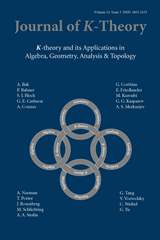Article contents
Periodicity of hermitian K-groups
Published online by Cambridge University Press: 16 May 2011
Abstract
Bott periodicity for the unitary and symplectic groups is fundamental to topological K-theory. Analogous to unitary topological K-theory, for algebraic K-groups with finite coefficients, similar results are consequences of the Milnor and Bloch-Kato conjectures, affirmed by Voevodsky, Rost and others. More generally, we prove that periodicity of the algebraic K-groups for any ring implies periodicity for the hermitian K-groups, analogous to orthogonal and symplectic topological K-theory.
The proofs use in an essential way higher KSC-theories, extending those of Anderson and Green. They also provide an upper bound for the higher hermitian K-groups in terms of higher algebraic K-groups.
We also relate periodicity to étale hermitian K-groups by proving a hermitian version of Thomason's étale descent theorem. The results are illustrated in detail for local fields, rings of integers in number fields, smooth complex algebraic varieties, rings of continuous functions on compact spaces, and group rings.
- Type
- Research Article
- Information
- Copyright
- Copyright © ISOPP 2011
References
- 3
- Cited by


